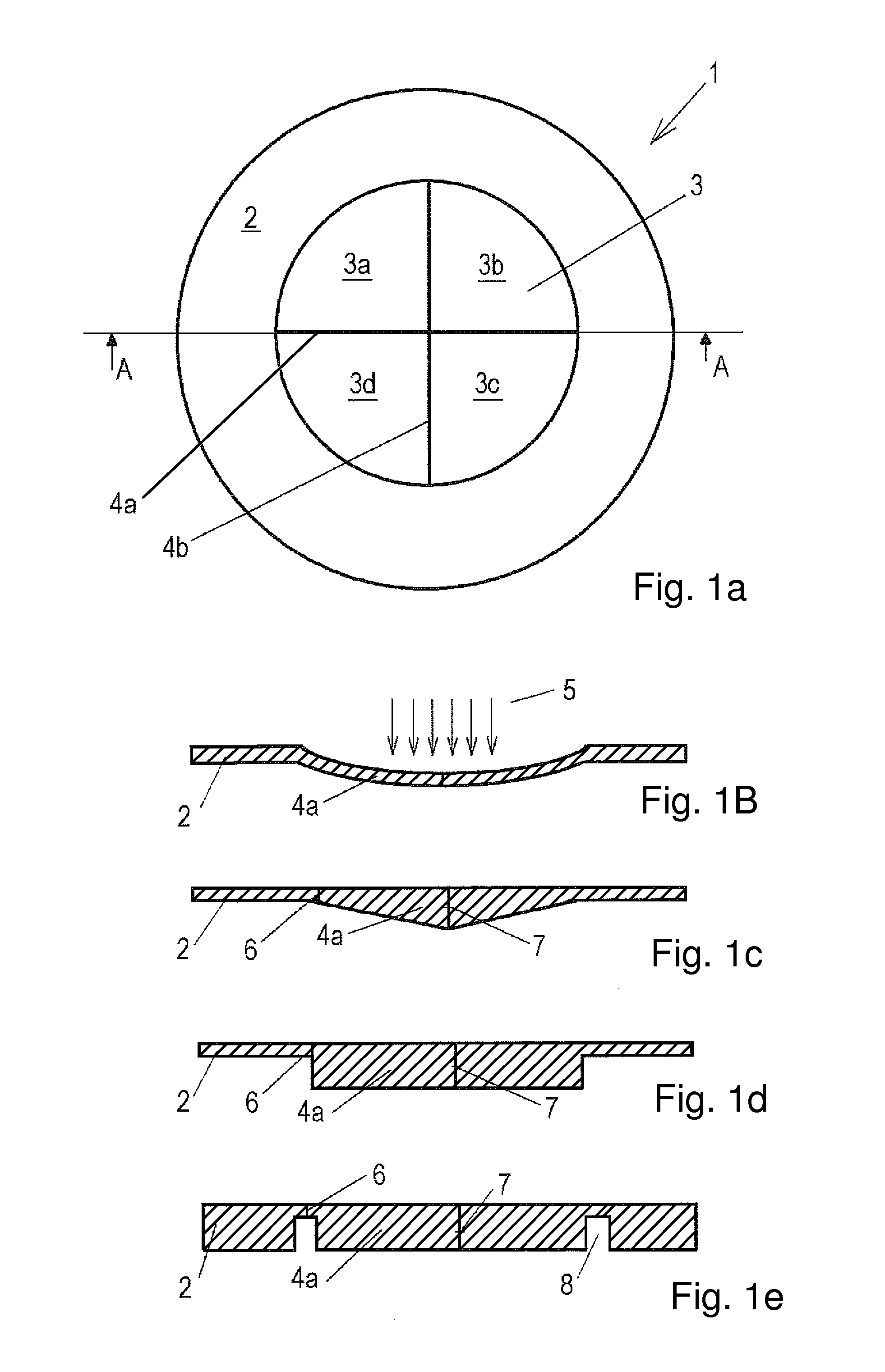[0012]The object of the present invention is therefore to make available a valve for use in the pneumatic switching circuit of a respirator, by means of which the above-mentioned drawbacks are overcome. In particular, it is the object of the present invention to make available a valve for use in or at a tube (e.g., an endotracheal tube or a tracheotomy cannula) coupled with the respirator, by means of which a pressure drop in the lungs of a patient (especially of an ARDS patient) can be effectively prevented from occurring.
[0014]An essential advantage of the slot valve according to the present invention is that the valve acts bidirectionally and responds independently from the direction of flow or the direction of action of a fluid at different threshold pressures.
[0016]The slot valve according to the present invention is preferably used in the pneumatic switching circuit of a respirator and is consequently arranged in the flow path between the respirator and the patient to be respirated, especially an ARDS patient, who is preferably respirated in the PEEP mode. The pressure drop in the patient's lungs to below a predetermined pressure level of, for example, between about 5 and 15 mbar can be prevented from occurring by means of the slot valve according to the present invention during disconnection at the endotracheal tube or at the tracheotomy cannula (when, for example, the respirator is being replaced). Furthermore, the valve is designed to make inspiration possible without the patient having to generate a high suctioning pressure for this. The threshold value for opening the valve in the suction direction is therefore preferably below 5 mbar. The necessary threshold pressure to open the valve must be higher in the direction of expiration and equals more than 5 mbar, preferably more than 10 mbar or in exceptional cases more than 15 mbar, and these values may also vary in an especially advantageous embodiment depending on the patient to be respirated, depending on the intensity of the ARDS and depending on other factors. Furthermore, the valve is designed to make it possible to suction fluids from the lungs by means of a special cannula. The slot valve according to the present invention has a hygienic design, which permits use for more than 1 week. In a preferred embodiment the valve is designed in a special manner in order not to hinder the flow of breath during normal respiration. The slot valve according to the present invention is provided for this purpose with means that can be actuated manually in order to make a changeover between different modes of operation possible in a simple manner.
[0022]The valve according to the present invention may be designed, furthermore, as a “pop-up” valve. A depressible or foldable, annular intermediate area is provided for this between the inner, circular slot area and the outer supporting ring. This intermediate area is folded up or into one another in the closed resting state of the valve or in the state that prevails when the patient is breathing in and only a low threshold value (overpressure on the side of the respirator) is necessary for opening the membrane lamellae. When the patient is breathing out (overpressure on the patient side), the folded-up intermediate area is first unfolded. If the pressure rises further and exceeds said threshold value (e.g., 10 mbar or more), the membrane lamellae are folded over as well. It was found that the membrane lamellae are pressed better against each other when the intermediate area is folded up and overpressure prevails on the patient side. It is only when the intermediate area is unfolded that the transition section between the membrane lamellae and the intermediate area acquires the necessary flexibility to make it possible for the membrane lamellae to fold over easily when the patient-side pressure exceeds the predetermined threshold value during expiration. The foldable intermediate area thus acts as a kind of securing means against premature folding over of the membrane lamellae under the threshold pressure.
[0023]A releasing means, which folds the membrane lamellae out of the closed position on actuation, so that the flow channel in the interior of the valve is released, is additionally provided in another advantageous embodiment of the present invention. In a preferred embodiment of the slot valve according to the present invention, the valve is inserted into the breathing circuit between an endotracheal tube or a tracheotomy cannula on one side (patient side) and the filter, artificial nose, closed suction system or Y-piece on the other side (respirator side). The valve has a housing, a slot membrane with, for example, four or six radially extending slots, as a result of which cut membrane lamellae are formed, a rotary ring and a spreader. The spreader can be pushed into the range of action of the slot membrane such that the membrane lamellae of the slot membrane permanently release the flow center and do not represent a relevant flow resistance. The spreader has two oblique holding noses, which open through the housing into a groove of the rotary ring, which said groove is designed as an oblique path. The rotary ring additionally has an annular groove, into which snaps a bead of the housing. As a result, the rotary ring is fixed against axial displacement at the housing. When rotating the rotary ring, the spreader is displaced axially over the two oblique paths and can thus be brought optionally into a position close to the Y-piece, where the spreader does not mesh with the membrane and a pressure drop in the patient's lungs below, for example, 10 mbar is avoided. The spreader meshes with the membrane lamellae in the opposite position near the patient and pushes same out of the flow center, whereby unhindered, bidirectional flow of fluid through the valve is made possible.
 Login to View More
Login to View More  Login to View More
Login to View More 


